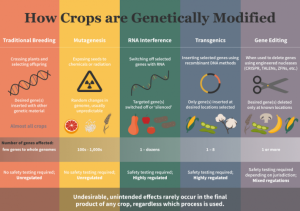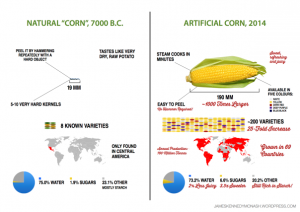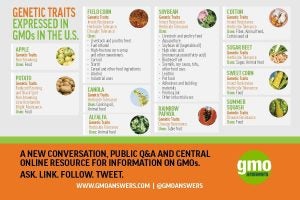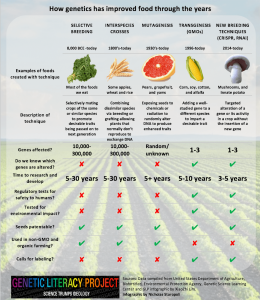Though extremely regulated and limited in number, GMOs are some of the most wildly misunderstood and polarizing food items available today
I’m sure by now you’ve at least heard the term “GMO.” Even if you’re not quite sure what the term means, you’ve probably seen labels on foods that specify “non-GMO.” There are quite a bit of misconceptions and myths surrounding that term and what GMOs actually are. But it’s important to separate the GMO myths from the GMO facts and to shine a real light on how GMOs crops impact today’s farmers and our modern food system.
Here are the top 8 myths surrounding GMOs and the non-GMO label:
Myth #1: ‘Non-GMO’ means that the food has not been genetically modified.
Truth: Virtually all modern day crops have been genetically modified — even the ones that are labeled “non-GMO.” While GMO does stand for “Genetically Modified Organism,” this term is misleading because it is only referring to one of many genetic modification techniques — transgenesis. The graphic below shows just some of the many different crop modification techniques that have been utilized to create virtually all of the crops available today. Many crops were barely edible or were inedible thousands of years ago.
An example of artificial selection is the selective breeding of the teosinte plant into sweetcorn. An example of mutagenesis is the mutant “Star Ruby” grapefruit created through mutations induced by ionizing radiation. These are both examples of crops that have been genetically modified, but are not considered to be “GMOs” by many media outlets and in other modern literature. In fact, there’s a database of thousands of mutant crops that have been developed by humans via mutagenesis, and there are thousands more genetically modified crops that have been created via traditional breeding as well as many other methods. Yet, as described by the U.S. Food and Drug Administration, some popular media and organizations have chosen to narrow the definition (technically incorrect, though becoming more commonly accepted by consumers) to only include “a plant, animal, microorganism or other organism whose genetic makeup has been modified in a laboratory using genetic engineering or transgenic technology.”


Myth #2: GMOs can’t occur naturally like the other types of genetic modification can.
Truth: Contrary to popular belief, GMOs, or transgenic crops, actually can occur naturally. Whether a crop has been genetically modified with or without human intervention tells you precisely nothing about the safety of that crop. While it is true that the other modification techniques such as cross-breeding and mutagenesis can naturally occur without human intervention, so can horizontal gene transfer. Bacteria and viruses regularly transfer genes between different species. In fact, a 2019 study revealed that 39 plant species qualify as natural GMOs. They contain the Agrobacterium microbe, which is the very same bacterium that scientists typically use to create GM crops. These natural GMOs include crops such as bananas, peanuts, Surinam cherries, hops, cranberries, and tea. So, crops created via all of the different genetic modification techniques, including “GMOs” can occur naturally as well as can be created with human intervention to create plant varieties that cannot and do not exist in nature.
Myth #3: GMOs can change your DNA when you consume them and can cause cancer.
Truth: Just as the genes in a banana don’t alter your DNA when you eat a banana, the genes in GMOs do not alter your DNA when you consume them either. Our digestive system breaks down DNA without any effect on our genetic make-up. Our own genes are made by our bodies from the building blocks that we acquire from digesting any food, whether it is considered to be a GMO or not. In fact, many foods that are considered to be “GMO” are refined to the point where no genetic material is even present. This is true for ingredients such as sugar, syrups, and refined oils. In addition, it is an international scientific consensus that GMOs are just as safe and at least as nutritious as their non-GMO counterparts.
Another thing to understand is that DNA is DNA. DNA is a code. There is no such thing as a tomato gene or a fish gene. DNA is made of the same four bases A, T, C, and G in all organisms. The arrangement of the bases determines which proteins an organism will make and how those proteins will be arranged. There’s nothing inherently tomato-like about a tomato gene or fish-like about a fish gene. In fact, humans share about 50 percent of our genes with bananas!
Myth #4: Every food at the grocery store is GMO unless it has a non-GMO label.
Truth: There are only 10 GMO crops on the market in the U.S. The non-GMO label is a voluntary label that companies pay for. If a product does not have the non-GMO label, it does not mean that it contains ingredients from GMO sources. Varieties of the following 10 GMO crops are approved in the U.S.: apples, potatoes, field corn, sweet corn, canola, alfalfa, soybeans, rainbow papaya, cotton, sugar beet and summer squash. One addition is the recently approved AquAdvantage Salmon. So, if you see anything about GMO wheat, GMO tomatoes, or GMO popcorn, you can be sure it is false. In addition, non-GMO labels are not mandatory. Companies pay for non-GMO certification in order to be able to place the “non-GMO” label on a food package. These labels can be put on products that don’t even have a GMO counterpart; for example, you may see a non-GMO label on a bag of popcorn even though there is no GMO popcorn sold commercially in the U.S or anywhere else in the world.

Myth #5: GMOs are a plot by Monsanto to sell more pesticides and to control the seed market with their patented seeds.
Truth: There are many different GMOs that were developed to exhibit various traits, and Monsanto (now Bayer) is just one of many companies that sells GMO seeds. The argument always seems to arise when discussing GMOs that they are some sort of plot by Monsanto to sell more pesticides and to control the seed market. The truth is that companies have been patenting seeds long before GMOs were around. Many organic growers use patented seeds and pesticides as well. The reality is that it takes an average of 13 years and $136 million to bring a genetically engineered crop to market because they are so highly regulated, so it makes sense that they’d protect that investment through a patent. This is not something unique to GMOs.
In addition, there are companies other than Bayer that sell GMO seeds and pesticides. Although people will cite the increase in glyphosate (an ingredient in various herbicide brand names, including Roundup) in the past few decades as proof that GMOs have led to an increase in pesticide usage, this is misleading. First, glyphosate has replaced much harsher pesticides. Second, the population of the U.S. has increased, and the amount of food each acre produces has also increased. Pesticide use has decreased — both per unit produced and per capita — from almost three pounds per person per year in 1980 to less than two pounds per person per year in 2008. Third, pesticide quality has improved since the 1960s and has become less toxic, more potent (leading to lower application rates), and less persistent in the environment. Over the last 20 years, GMOs have actually reduced pesticide applications by 8.6 percent.
Myth #6: Seed companies sue farmers if GMOs blow into their fields.
Truth: This has never actually happened. Seed companies can sue for knowingly using their seeds without licensing agreements or for saving seeds despite signing a technology agreement that restricts farmers from saving part of their crop and using it as seed in a subsequent year. The myth that they have sued farmers who unknowingly have GMOs in their field was spread by misrepresenting cases like that of Canadian farmer Percy Schmeiser, who claimed that he was sued when Roundup Ready canola plants were discovered on his farm. However, the Canadian court that heard the case concluded that Schmeiser intentionally planted Roundup Ready canola seeds. In addition, saving seeds isn’t something many farmers typically do, whether hybrid or GMO, because they don’t breed true. So, this is not a new issue nor is it unique to GMOs. Farmers choose what seeds they want to purchase, so if they want to save seeds, they are able to purchase seeds not under any type of patent. Additionally, in many public sector projects — such as the Hawaiian papaya, insect-resistant eggplant in Bangladesh, and Water Efficient Maize for Africa — farmers are free to save and share GMO seeds and no royalties are charged.
Myth #7: GMOs have not been adequately tested for safety
Truth: GMOs are actually much more regulated than their non-GMO counterparts. It takes an average of $130 million and 13 years to bring a new GMO to market, which involves a comprehensive safety and environmental review by regulatory bodies around the world. In addition to the review process conducted in the U.S. by the Department of Agriculture, the Environmental Protection Agency and the Food and Drug Administration, other nations conduct their own rigorous certification processes and regulatory approvals. Currently, more than 40 agencies and 67 countries certify genetically modified products for cultivation, importation and/or field trials and testing. Unlike new varieties of crops produced by other methods of genetic modification, GMOs on the market today are tested for food safety, including for allergenicity, digestibility and toxicity. On average, more than 75 different tests are performed to ensure that GMOs are safe for people, animals, and the environment. The safety of the end product is what matters for the consumer, not the process used to get to that end product.

Myth #8: GMOs are bad for the environment.
Truth: There are many environmental benefits associated with GMOs. Over the past 20 years, GMOs have reduced pesticide applications by 8.6 percent and helped increase crop yields by 22 percent. Reduced pesticide use associated with insect resistant GM crops and reduced tillage that is possible with herbicide tolerant crops are believed to be beneficial to bee populations and other pollinators. GMO crops contributed to sustainability and climate change solutions by conserving biodiversity — in 2018 alone they helped save 59.7 million acres of land and reduce CO2 emissions by 50.7 billion pounds, equivalent to taking 15.3 million cars off the road for one year.
Herbicide-tolerant genetically engineered crops enable farmers to till less often. This has increased nutrient-rich organic matter up to 1,800 pounds per acre per year. In addition, GM traits can help farmers produce crops that are more resistant to extreme weather conditions, such as drought and extreme heat, and non-browning traits can allow for reduced food waste. GMOs can help to reduce food waste in developing countries where these losses can be as high as 40 to 50 percent for root crops, fruits, and vegetables, 30 percent for cereals and fish, and 20 percent for oilseeds.
Although a lot of the negative press GMOs get is largely untrue, GMOs are not a panacea. Yes, they can absolutely benefit the farmer, environment, and consumer, but the technology used to create GMOs is just one of many tools. Most of the arguments against GMOs are not unique to GMOs. These same arguments and concerns can be applied to all of the other modification techniques as well. There are pros and cons associated with all aspects of different crop modification techniques and farming methods. No one single plant breeding method or agricultural system will feed the world in a sustainable manner. They can all contribute and continue to be improved.
Food Science Babe is the pseudonym of an agvocate and writer who focuses specifically on the science behind our food. She has a degree in chemical engineering and has worked in the food industry for more than decade, both in the conventional and in the natural/organic sectors.



